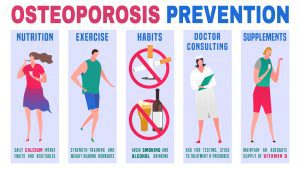
With initial diagnosis of osteoporosis often taking place after a breakage has occurred, Health Europa discusses the importance of osteoporosis prevention measures to protect bone health with Dr Amit Patel.
As with many chronic conditions, particularly as we age, our lifestyle can play a huge part in determining the likelihood of their development. When we consider osteoporosis – a condition where bones become progressively weaker and more susceptible to breakage – there is a growing body of research to support our understanding of bone health and therefore reduce our susceptibility to the condition. However, where the greatest burden of osteoporosis lies is in diagnosis as initial indications of the disease often only come to light after a breakage has occurred. To discuss the importance of osteoporosis prevention, Health Europa spoke to Dr Amit Patel, founder of Pharmanovia, a company which specialises in driving forward late-stage activities for high-quality prescription medicines across therapeutic areas including women’s health and endocrinology, cardiovascular, neurology and pain.
What is the significance of early diagnosis in treating and relieving the burden of osteoporosis?
By its very nature, osteoporosis is largely diagnosed in patients who present with fractures or bone damage. Early screening is the best way to get ahead of this, to alleviate the burden of those suffering. Nobody walks into their doctors and says ‘I believe I have osteoporosis’. Instead, most people are unaware they have the condition until they seek medical treatment for a broken bone, vertebra or worse. Only then is the condition subsequently diagnosed. That is why it is vital to get ahead of the curve, to manage and relieve the burden of osteoporosis as early as possible. This is incredibly important from a cost perspective because it prevents the progression of osteoporosis, meaning patients will not suffer further broken, shattered or crushed bones. Diagnosis via a DEXA scan is a straightforward, cost-efficient tool that gives a definitive diagnosis. Only once you have received a diagnosis you can be prescribed the relevant treatment.
One cannot forget that a fracture experienced in later life, often by those living with comorbidities, can impact long term mobility and lead to an increase in patient care requirements in the community.
According to the International Osteoporosis Foundation, it is estimated that only one third of vertebral fractures come to clinical attention and likewise, underdiagnosis of vertebral fracture is a worldwide problem. Can you highlight some of the key issues associated with osteoporosis diagnosis and care?
Osteoporosis does not have the same public profile as other conditions. Patients know about the various cancer screening programmes available, but in the case of osteoporosis prevention, that awareness is not at the level it should be. Fundamentally, the main problem is that most people are unaware they have osteoporosis, hence the underdiagnosis of the condition. Disease awareness campaigns are essential, for both patients and prescribers, to improve patient access to treatment and get to a point where patients seek medical help earlier.
Some argue there should be additional screening or checks in place for those going through menopause, across all countries. As it stands, screening programmes and tools vary from country to country, depending on which healthcare system a patient is treated under. The main gateway to treatment is through primary care.
Menopause can dramatically increase the risk of osteoporosis, what preventive or protective lifestyle measures can women take to lessen their risk of developing osteoporosis while going through menopause?
It is incredibly important to remain active because osteoporosis is much more common in those with a very sedentary lifestyle. Smoking is another factor that increases the risk of osteoporosis. A healthy diet with a lot of vitamin D and calcium reduces the risk of developing osteoporosis and eases the severity of the condition.
Western diets tend to have an ample balance of calcium, but vitamin D is more of a challenge because sunlight on the skin is necessary for vitamin D to become active in our bodies. This is where supplements can help osteoporosis prevention.

Can you outline any challenges associated with treatment decisions and treatment uptake?
Fundamentally, diagnosis of osteoporosis is currently based on an arbitrary number that is determined by factors such as age, sex, and bone density. If a patient is a certain standard deviation away from the ‘normal’, they are then diagnosed as having osteoporosis and offered to start treatment. Until a patient gets that test, they are not able to access these treatments.
How could digital solutions support both patients and healthcare systems with the screening, treatment, and management of the condition?
Patients sometimes view osteoporosis as part of the normal ageing process. There are two major problems presented by this, which are low rates of preventive screening as well as patients not fully understanding the consequences of their diagnosis (Source: Brett Crist, Assoc Prof Missouri School of Medicine). Improved patient education, assessment of risk factors, advice, and nudges on modifiable behaviours (e.g., smoking, diet) are all interventions that are suited to digital solutions.
The key is to design digital solutions that encourage patients to buy into the personal benefits of behaviour change, which is particularly challenging with a disease such as osteoporosis which can be largely asymptomatic (until a fracture). Digital platforms can help patients to understand their progress better, make more informed decisions at each stage of their journey and provide more insightful data back to their clinicians. More personalised treatment pathways delivered through digital solutions can lead to greater patient engagement with their disease, better clinical decision making, greater self-management, and ultimately fewer fractures.
Dr Amit Patel
Founder
Pharmanovia
pharmanovia.com
This article is from issue 21 of Health Europa Quarterly. Click here to get your free subscription today.






















